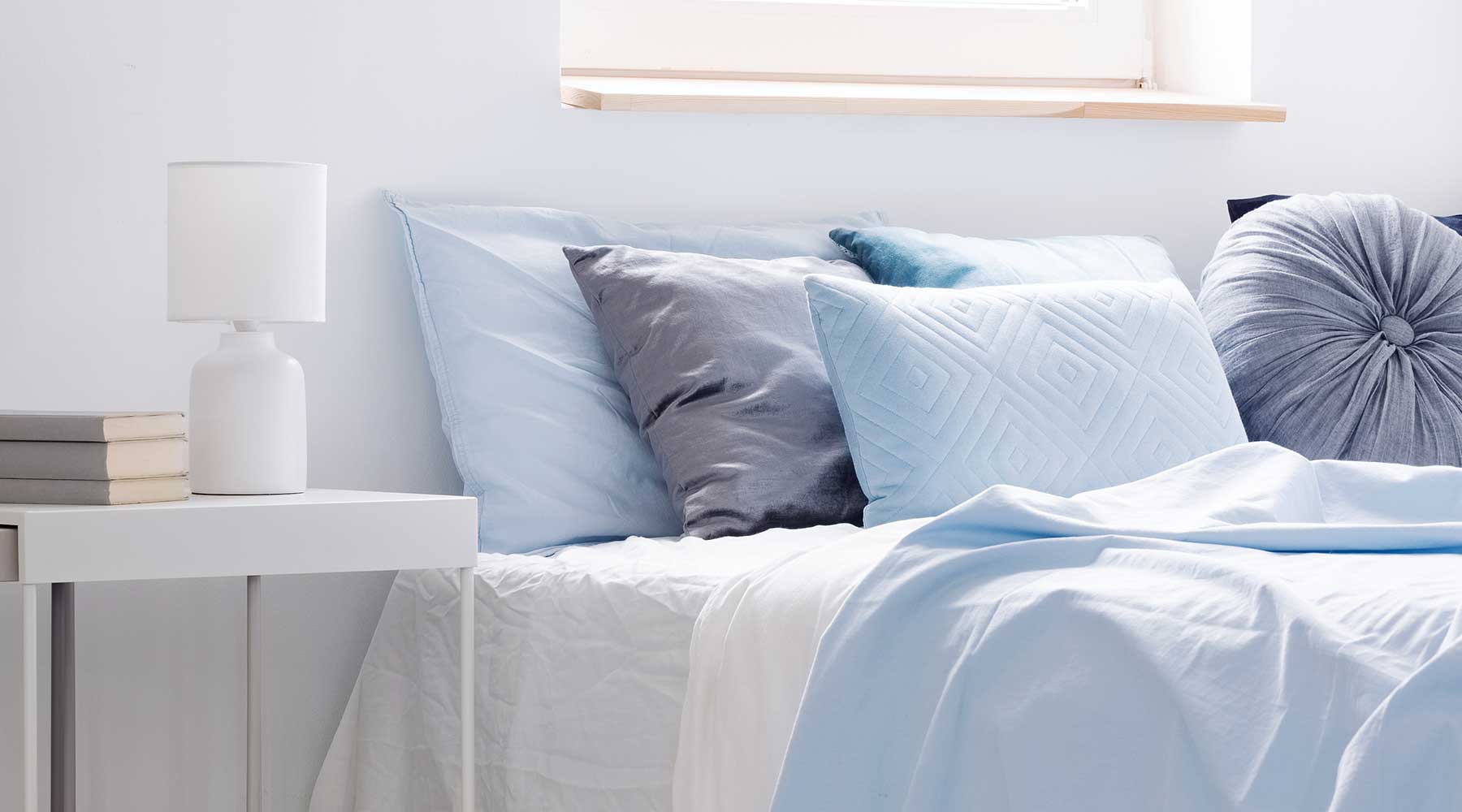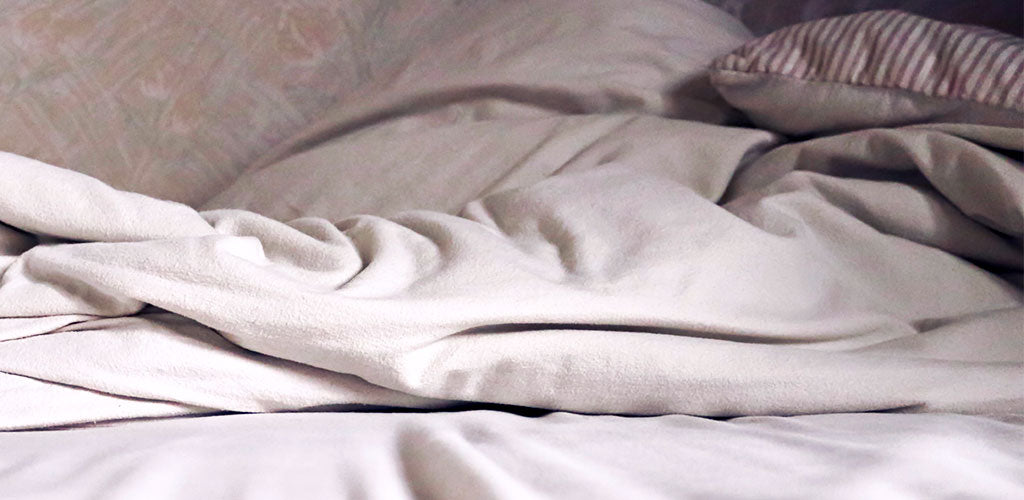
Which bed linen material is best?
The material of our bedding is crucial for a comfortable sleeping environment and can help prevent you from sweating or freezing, especially in summer and winter. Here, we explain how the right pillowcase and duvet cover can improve your sleep and which fabrics are best for you.
Table of contents
- The right bed linen for a good night's sleep
- The best fabrics for pillow and duvet covers
- Bed linen for every season
- Cool bed linen for summer
- Warm bed linen for winter
- Conclusion
1. The right bedding for a good night's sleep
Whether smooth and airy or fluffy and warm – the type of bed linen we use is crucial for our well-being and also influences whether we experience a restful night. In addition to the actual pillow and the duvet, the material of our bed linen also plays an important role in ensuring a good sleeping environment and thus enabling a restful sleep.
At night we lose a lot of heat and moisture through our skin and our breathing and are particularly affected by Summer or under a thick winter duvet, we quickly start to sweat. Accumulated heat and sweat are absorbed by our bedding through direct skin contact. A suitable pillowcase and duvet cover are therefore important to absorb sweat and moisture and help maintain normal body temperature so we don't sweat too much or freeze too much at night, and our sleep isn't disturbed.
In addition to heat and moisture, we also lose numerous skin particles and hairs during the night, which in turn attract mites and bacteria. But no matter what type of bedding we choose, the covers should be changed regularly and washed at 60 degrees Celsius, if possible, to completely remove dust and mites and ensure hygienic care. Sleeping environment to ensure.
2. The best fabrics for pillowcases and duvet covers
Which material you should choose depends primarily on your sleeping situation as well as your personal needs and preferences. When choosing pillowcases and duvet covers, it is generally recommended to choose a fabric that can absorb sweat and help regulate your sleeping temperature. We'll give you an overview of the most popular types of bed linen and show you which materials are particularly suitable for sleeping in summer or winter suitable.
#1 Bedding for every season
Cotton
Cotton bedding is widely used and very popular. Cotton is a robust natural fiber that is particularly absorbent, breathable, and durable. It can absorb up to 65% of its own weight in moisture and is also characterized by a pleasantly soft surface texture and high durability. Cotton pillowcases and duvet covers are very robust and, depending on the processing, can be cleaned even at high temperatures (up to 95 degrees Celsius), making them ideal for year-round use and promising a hygienically clean sleeping experience.
Microfiber
Artificial microfiber is usually made of polyester and is a cost-effective and easy-care alternative to natural cotton. Microfiber bedding is less breathable, but is easy to clean, pill-free, and dries very quickly. These artificial fibers are also versatile and ideal for allergy sufferers because pollen, mites, dust, and bacteria cannot settle in the fabric.Microfiber is available in a wide variety of designs and can be used in any season.
#2 Cool bedding for summer

In hot summer temperatures, we tend to sweat more at night, or we rely on fans, air conditioning, and open windows to improve the air and temperature conditions. Therefore, you should not go without a duvet and suitable sleepwear, even in summer, because sweat on the skin, combined with drafts, can Tensions and lead to colds. In summer, light, thin, and breathable materials are particularly suitable, as they wick heat away from the skin and absorb moist sweat.
Silk & Satin
Silk is a particularly high-quality, lightweight, and flowing fabric characterized by a very fine, smooth surface. The natural silk fabric is extremely air-permeable and breathable, can absorb a lot of moisture, and dries very quickly. Silk bed linen therefore has a pleasantly cooling effect on the skin and is ideal for sleeping in warm temperatures. However, this fine material is delicate and can only be washed very gently.
The cheaper and easier-care alternative to silk is satin. This lightweight, smooth, and shiny satin fabric is made from cotton or microfiber, is breathable, and its fine surface texture also leaves a pleasant, cooling feeling on the skin.
Seersucker
The airy and lightweight seersucker is also perfect for sleeping on warm nights. This cotton fabric is known for its creped surface, which rests unevenly and lightly on the body, allowing air to circulate well between the duvet and body. This allows excess heat to be dissipated and a pleasantly cool sleeping environment is maintained. Seersucker is also one of the easier-care bedding fabrics, being easy to wash and requiring no ironing.
Linen & half-linen

Linen is a smooth, robust, and very high-quality natural fiber characterized by its natural appearance, making it ideal for summer bedding. Linen pillowcases and duvet covers absorb a lot of moisture and dry quickly, feeling cool and airy against the skin. They are antibacterial and can be easily cleaned at high temperatures, making them ideal for use on warm summer nights.
#3 Warm bedding for winter
For a cozy and cuddly Sleep in winter Soft, dense fabrics are ideal. Combined with the material of your pillow and duvet, they retain body heat well, yet are still breathable and absorbent. Even in cooler ambient temperatures, we lose a lot of heat and moisture through our skin and breathing, which shouldn't be allowed to build up.
Flannel/beaver

Flannel and the slightly finer flannel are made from a dense, brushed cotton fabric. The material's texture creates a cuddly soft, warming surface that is still breathable and moisture-regulating. This keeps the body warm, especially in cool ambient temperatures, without causing sweating. Flannel bedding is also very easy to care for and can be easily washed, making it ideal for sleeping on cold winter nights or as a fluffy cover for children's pillows and blankets.
3. Conclusion
-
The material of our pillow and duvet covers can influence the sleeping environment and support restful sleep.
-
Duvet covers made of cotton or microfiber are suitable all year round because they are breathable, moisture-regulating and easy to care for.
-
In summer, airy materials such as silk & satin, seersucker or linen provide a cool feeling on the skin and help against sweat and accumulated heat.
-
Perfect for winter is thick flannel or beaver fabric, which warms the body well and leaves the skin feeling soft and cozy.
Best wishes and see you soon!



Leave a comment
This site is protected by hCaptcha and the hCaptcha Privacy Policy and Terms of Service apply.